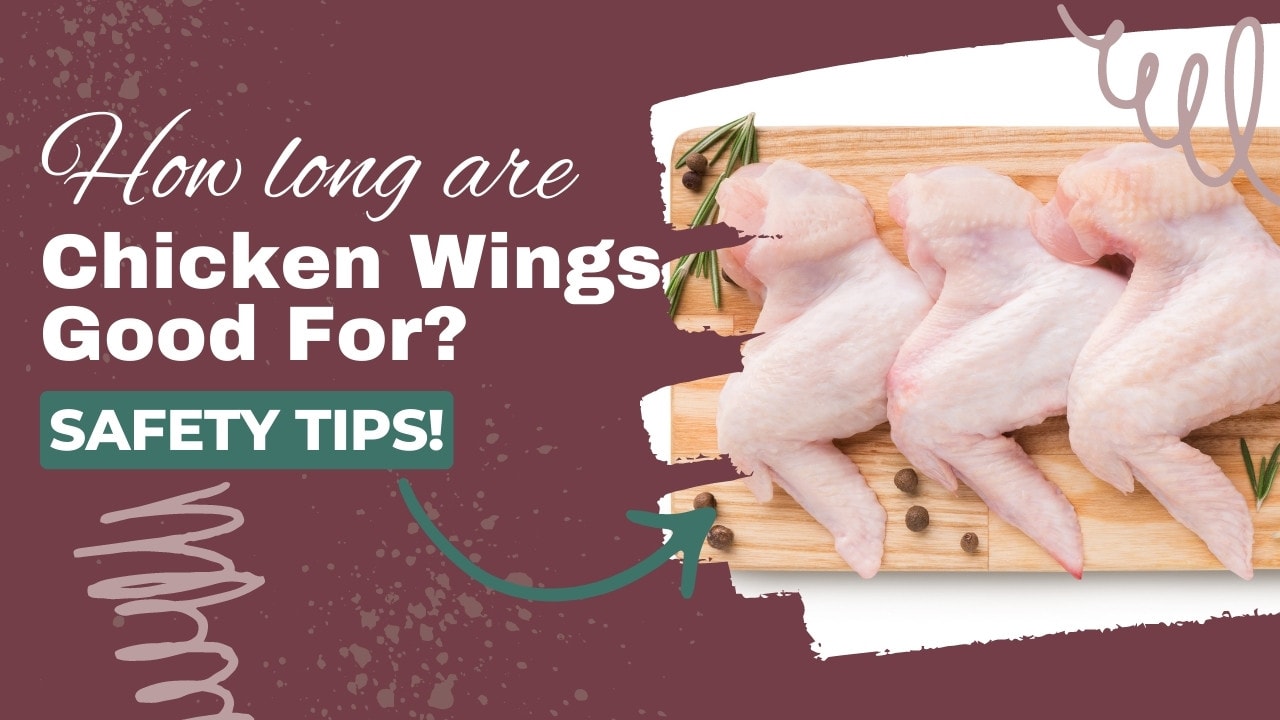DISCLAIMER: THIS PAGE DOES NOT PROVIDE MEDICAL ADVICE.
This page is intended for informational purposes only. No material on this page is intended to be a substitute for professional medical advice, diagnosis, or treatment. Always seek the advice of your physician or other qualified healthcare provider before changing your dietary or cooking habits.
Crispy, juicy chicken wings are a great snack or meal for any time of day. (Yes, I eat them for breakfast.) However, with their high ratio of surface area they don’t last very long in the fridge.
Obviously, like with any meat, raw chicken wings need to be cooked or chilled immediately after buying them or they will spoil in a couple of hours. Let’s look at USDA recommended lengths of time to store chicken wings – raw or cooked – for maximum freshness.
How Long are Chicken Wings Good For?
- Fresh Wings – Up to 2 days in the refrigerator or until “use by” date.
- Frozen Wings – Up to 6 months in the freezer or until “use by” date.
- Cooked Wings – Up to 3 days in the fridge if chilled shortly after cooking.
- Cooked Wings sitting out in a party bucket – Eat ‘em or toss ‘em within 2 hours.
Chicken wings can last up to two or three days in the refrigerator and up to six months in the freezer. They need to be wrapped and stored properly and inspected when thawed and before eating.
How Long Do Fresh Chicken Wings Last In The Fridge?
Raw chicken does not have a very long shelf life. Bacteria such as Staphylococcus aureus, Salmonella Enteritidis, Escherichia coli O157:H7, and Campylobacter (all quite nasty and dangerous) grow on protein-rich chicken meat quickly. So the faster you cook it, the better!
If you need to store your fresh chicken wings in the refrigerator, FoodSafety.gov recommends keeping it for only 1 or 2 days.
Keep The Wings Away From Other Foods
Raw chicken most likely carries some level of harmful bacteria, and can spread bacteria very easily. If there are other foods in your refrigerator, you should make sure the chicken doesn’t come in contact with them. Store them at the bottom of the fridge. Not only is that the coldest spot, but it prevents liquid from the meat package from dripping on other items in your fridge.
How Long Do Cooked Chicken Wings Last In The Fridge?
If you have already cooked your chicken wings and want to save them for later, the key to safe storage is to get them into the fridge as soon as you can after cooking.
So if you think you’re going to have leftovers, get them in the fridge as soon as they’re done frying; don’t wait until they’ve been sitting out for three or four hours while you watch the football game!
Cooked chicken wings can last up to three days in the refrigerator if packaged properly and stored as soon as possible after cooking. Put them in an airtight container and tuck them into the bottom of your fridge where it stays consistently cold.
Always check the chicken wings before you eat them, even if you followed the rules for storing them. And reheat them thoroughly to an internal temperature of 165F before consuming.
How Long Do Chicken Wings Last In The Freezer?
This won’t surprise anyone, but chicken wings last much longer in the freezer than the fridge. The guidelines for freezing chicken is a maximum of six months, whether cooked or raw. The more time goes on, the higher the risk of freezer burn to the meat, accidental thawing, or slow buildup of illness-causing bacteria.
Storing the chicken wings properly is a key factor in making the wings last as long as possible. They need to be kept in a freezer bag or an airtight freezer container.
If you plan to split up the wings so you can cook them separately or in smaller batches, it’s best to do so before freezing. They’ll thaw more quickly and easily if you freeze them in small batches.

You can also freeze cooked chicken wings and expect them to last around six months too. They should also be packaged the same way. Whether you are freezing fresh or cooked chicken wings, always label them and add a date so you know how long they last.
Watch for Signs of Thawing
If your freezer dies, or you have a power outage, or the kids leave the door ajar and the food inside warms to above 40 degrees, illness-causing bacteria could begin to grow on it. Chicken wings that have been partially thawed should be fully thawed and eaten as soon as possible.
Storing them towards the back of your freezer, rather than in the door, can help them stay fresh for longer. Wings may clump together or form a thick coating of ice crystals if they partially thaw in the freezer.
Label The Wings
Once you have packaged your chicken wings and are ready to put them in the freezer, take a minute to label and date them. I always think I’m going to remember what stuff is when I stick it in the freezer – and inevitably forget.
Taking the lid off the containers to check what’s inside exposes the food inside to air and potentially bacteria, so it’s best to be able to know what is in the container without opening it.
How Can You Tell If Chicken Wings Are Bad?
Even if you handled your wings with care once you brought them home from the store, you don’t know how they were handled before they came to you. It’s wise to check your wings before cooking them, even if it’s not past the sell-by date.
How can you tell if chicken wings have gone bad? To be honest, you really can’t tell for absolute sure just by looking at it. Bacteria that cause food poisoning multiply alarmingly quickly at temperatures between 40°F and 140°F and can reach levels high enough to make you sick before the chicken is visibly spoiled.
The USDA Food Safety and Inspection Service reminds us that bacteria numbers can double on food left at “danger zone” temperatures for as little as 20 minutes.
Reheating Food Won’t Always Prevent Food Poisoning
I’m sure you’ve watched a roommate or a co-worker grab questionable leftover food off the counter with the dismissal, “I’ll just heat it up real good first. It’ll be fine.”
Unfortunately, heating food up before eating it, even heating it really hot, won’t necessarily make it safe to consume if bacteria have already multiplied on it to dangerous levels. According to the Washington State Department of Health (WSDH), common bacteria such as Staphylococcus aureus (staph) and Bacillus cereus leave behind toxins in food that are not destroyed by high heat, even if the bacteria themselves are reduced. The WSDH even goes so far as to claim that bacteria that makes food smelly isn’t necessarily bacteria that makes you sick.
That said, hear me loud and clear: if your chicken wings do smell off, unusually strong, or if they look gray or greenish, or if they feel slimy, or if they are past the “use by” date, please don’t consume them.
CDC stats estimate that 128,000 people in the United States are hospitalized each year due to food poisoning. About 3,000 of those cases are fatal. It’s not worth the risk.
Conclusion
Hot or honey, baked or fried, whole or party-style, chicken wings are an American staple. But they don’t last as long in the fridge as larger cuts of chicken.
Don’t buy chicken wings until shortly before you plan to cook them. Keep them frozen or refrigerated below 40°F at all times (they can be cooked from frozen!) until they’re ready to hit your oven or fryer. Heat and reheat wings to an internal temperature of 165°F or 74°F before consuming them. And always date your leftovers so you know how long they’re likely to be good.









